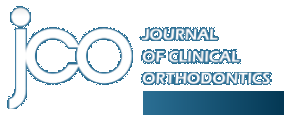Search Results For: 'case report'
1921.
THE EDITOR'S CORNER
Grading Your Own Treatment Results
Volume 9 : Number 3 : Page 129 : Mar 1975
Grading your own treatment results can be a painful procedure, but if it is done in a consistent and organized way, it can be one of the most constructive steps you can take to better orthodontic trea...
1922.
Volume 11 : Number 8 : Page 507 : Aug 1977
There is a growing controversy in orthodontics today over the expanded use of auxiliary personnel. We no sooner got done changing most of the state dental practice acts to permit expanded duties to be...
1923.
Upper Anterior Occlusal Plane Control
Volume 12 : Number 9 : Page 656 : Sep 1978
Upper incisor position plays an important role in the esthetics of the smile, in the rest position of the lip, in supporting the lower lip and in determining the anterior occlusal plane, which is the ...
1924.
ORTHODONTIC OFFICE DESIGN
Volume 13 : Number 10 : Page 702 : Oct 1979
Most orthodontists feel a special consultation area is preferable to presenting the case analysis at the dental chair. Only large offices can afford the luxury of a separate area devoted to consultati...
1925.
Volume 16 : Number 9 : Page 606 : Sep 1982
Many orthodontists have been of the opinion that very young children and adults could not or should not be treated orthodontically, but that idea has been changing, giving these two groups a chance to...
1926.
Volume 21 : Number 5 : Page 0 : May 1987
This month's topics are bicuspid extractions and "professional courtesy".1. What are your opinions on the effectiveness of extracting second bicuspids vs. first bicuspids? What percentage of your acti...
1927.
THE EDITOR'S CORNER
Volume 23 : Number 5 : Page 0 : May 1989
Is It a Shot in the Dark? On March 24, 1989, the ABC television program 20/20 aired a segment on TMJ disorders. It presented a picture of suffering patients who may spend thousands of dollars with num...
1928.
THE EDITOR'S CORNER
Volume 24 : Number 4 : Page 0 : Apr 1990
Toward a New Orthodontics Until now, orthodontics has been based on a craft management model. There is a mechanical task to be done; we do it, retain it for a period of time, and dismiss the patient. ...
1929.
Anterior and Posterior Dental Changes in Second Molar Extraction Cases
Volume 24 : Number 9 : Page 0 : Sep 1990
Proponents of second molar extraction therapy suggest that it offers the advantages of both premolar extraction and nonextraction treatment while minimizing the negative effects of both approaches.1-1...
1930.
THE EDITOR'S CORNER
Volume 26 : Number 5 : Page 0 : May 1992
A Rose Is a Rose The Management & Marketing column by Dr. David Drake in this issue is one of the best articles I've read on the use of orthodontic staff. Although he covers the position of treatm...
1931.
Unusual Ectopic Eruption of Maxillary Canines
Volume 29 : Number 9 : Page 0 : Sep 1995
The maxillary permanent canine develops under the orbit, superior and palatal to the first premolar and lateral incisor. During its long eruption, the canine moves labially and mesially and can be pal...
1932.
Surgically Assisted Rapid Palatal Expansion
Volume 29 : Number 12 : Page 0 : Dec 1995
Transverse maxillary discrepancies are routinely corrected in growing patients with appliances that separate the median palatal and associated maxillary sutures.1,2 This type of rapid palatal expansio...
1933.
Osseointegrated Implants for Maximum Orthodontic Anchorage
Volume 7 : Number 7 : Page 412 : Jul 1998
Endosseous implants, which are commonly used to replace missing teeth in partially edentulous patients, may also provide ideal anchorage for mesiodistal orthodontic tooth movement, as demonstrated by ...
1934.
Segmental Lingual Orthodontics in Preprosthetic Cases
Volume 32 : Number 12 : Page 716 : Dec 1998
Segmental lingual orthodontic treatment offers several advantages in preprosthetic cases, including esthetics, efficiency, relatively simple and comfortable mechanics, and, ultimately, the ability to ...
1935.
CAD/CAM Fabrication of Occlusal Splints for Orthognathic Surgery
Volume 33 : Number 4 : Page 231 : Apr 1999
Occlusal splints used for intermaxillary positioning after orthognathic surgery require accurate positioning, stabilization, and control of the mobilized segments.1 Conventional fabrication of an oc...
1936.
THE EDITOR'S CORNER
Viewing the Child Patient as a Customer
Volume 34 : Number 2 : Page 69 : Feb 2000
Peter Drucker turned 90 the other day. You may have read his extraordinary book, The Practice of Management, which in one volume established management as a separate discipline. It did more than that...
1937.
Volume 36 : Number 2 : Page 67 : Feb 2002
The off-center bends and their variations have been discussed and illustrated. It is now time to see just how these bends will be used to control molar positioning. It should be emphasized that these ...
1938.
Modified Removable Transpalatal Bar for Rapid Uprighting of Impacted Second Molars
Volume 36 : Number 9 : Page 496 : Sep 2002
The in-office modification of a preformed transpalatal bar shown here offers a mechanically advantageous and efficient solution for uprighting an impacted second molar, especially when bonding a stand...
1939.
THE CUTTING EDGE
Volume 38 : Number 2 : Page 93 : Feb 2004
Which works best? An .018" slot or an .022" slot? A standard edgewise system or the latest available prescription? Which is more cost-effective? Should we employ the same appliances in all circumstanc...
1940.
THE EDITOR'S CORNER
Volume 39 : Number 7 : Page 395 : Jul 2005
The cardinal rule of case presentations is to allow enough time so that you can strongly encourage questions from patients and their parents. Failure to do so is simply courting disaster later on, and...
Showing 1921-1940 of 3241 results. Search completed in 0.155 seconds.

